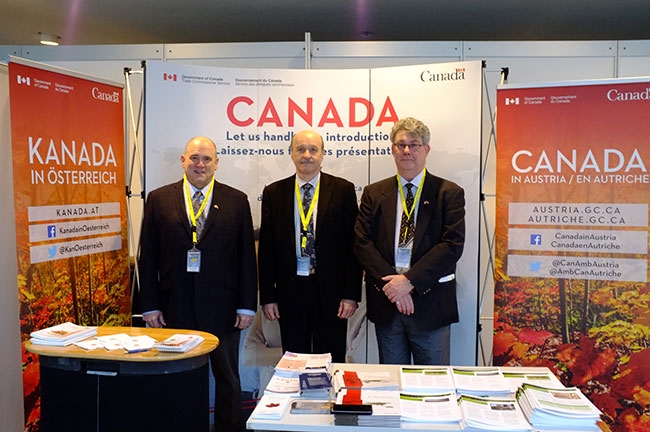
Promoting Canada’s wood pellets in Europe
March 22, 2017
By Gord Murray
March 22, 2017 - The Government of Canada and the Wood Pellet Association of Canada (WPAC) jointly sponsored the Central European Biomass Conference (CEBC), which took place in Graz, Austria from Jan. 18 to 20, 2017. One of our ongoing objectives is to position Canada as a reliable source of high-quality, sustainably produced wood pellets and the CEBC presented a good opportunity to do this. It is essential to continually reinforce to our European customers that our raw material comes from the most sustainably managed forests in the world.
 The Government of Canada and WPAC recently jointly sponsored the Central European Biomass Conference. The Government of Canada and the Wood Pellet Association of Canada (WPAC)
The Government of Canada and WPAC recently jointly sponsored the Central European Biomass Conference. The Government of Canada and the Wood Pellet Association of Canada (WPAC)In his opening remarks at the conference, Mark Bailey, ambassador of Canada to Austria, described Canada’s commitment to forest management and the government’s support of the wood pellet sector.
David Patterson, on behalf of the Canadian Council of Forest Ministers (CCFM), also gave a presentation, as did I. My presentation focused on Canada’s wood pellet sector, while David’s presentation described Canada’s forests, our country’s forest management regulatory framework, and Canada’s rank as the No. 1 country in terms of third party certified forests. With 166 million hectares of certified forests, Canada’s total is nearly four times that of second place United States at just 47 million hectares.
The CEBC is held every three years, attracting more than 1,100 participants from all over the world.
There is a home building fair attached to the conference, which showcased the latest in biomass boiler technology. The fair attracted 40,000 visitors. Austria is a leading bioenergy user with 17 per cent of its total energy and 57 per cent of its renewable energies being created with biomass.
In addition to attending the conference and hosting our exhibition booth, together with Canadian Trade Commissioner Nicole Mothes we met with several companies – including numerous pellet boiler manufacturers – who are interested in co-operating with WPAC and in doing business in Canada. These included Bioenergy 2020+ GmbH, Die Österreichische Forschungsförderungsgesellschaft (FFG), ETA Heiztechnik GmbH, Kraft & Wärme aus Biomasse GmbH (KWB), Fröling Heizkessel- und Behälterbau GmbH, Hargassner GmbH, HERZ Energietechnik GmbH, H. Stocker GmbH, Schmid Energy Solutions, and WVT Breiding GmbH.
As a result of our meetings, WPAC is co-operating with Bioenergy 2020+ GmbH. This federally funded Austrian company is engaged in applied bioenergy research including wood pellet combustion.
We are trying to put together a joint project with two objectives: (1) to convince Canada’s provincial boiler safety authorities to accept the Austrian biomass boiler standard EN 303-5 so as to facilitate the import of Austria pellet boilers to Canada; and (2) to establish a biomass boiler education and demonstration centre, likely in Eastern Canada.
If successful, Austrian boiler manufacturers will benefit by increasing their exports to Canada and potentially by establishing Canadian manufacturing.
Canadian wood pellet producers will benefit from increased pellet demand as more boiler systems are installed in
Canada.
During the CEBC, a full day was devoted to the European pellet sector. This included presentations from Austria, the Baltics, Bosnia and Herzegovina, Croatia, France, Germany, Italy, Serbia, Slovenia, Sweden, and Ukraine. Here are a few highlights:
- The ENplus quality certification now exceeds 700 certified companies and 8 million tonnes of annual production.
- Europe’s pellet production in 2015 was 14.1 million tonnes. Total consumption was 20.3 million tonnes. Interestingly, the pellet heating sector, at 10.3 million tonnes, made up 51 per cent of consumption – outpacing the highly-publicized utility mega-projects like Drax Power and Dong Energy. Assuming each European home consumes about 2.5 tonnes per year, the European pellet heating sector has an estimated 4 million customers.
- The top six producing countries were Germany (2.0 mn t), Sweden (1.7 mn t), Latvia (1.6 mn t), Estonia (1.3 mn t), Austria (1.0 mn t) and France 1.0 mn t).
- The top countries consuming pellets for heat were Italy (3.1 mn t), Germany (2.3 mn t), Denmark (1.8 mn t), Sweden (1.6 mn t), France (1.0 mn t) and Austria (0.9 mn t).
- Stoves continue to outpace boilers. In Italy, stoves make up 95 per cent of consumption and boilers just five per cent. In second place is Germany, where stoves make up 60 per cent of consumption and boilers 40 per cent.
- Small European countries are rapidly building pellet production capacity, nearly all of which is ENplus certified. Production from new market participants as of 2016 included: Ukraine 360,000 t (plus 1 million tonnes of pellets made from straw, peat, and sunflower husks), Serbia (250,000 t), Croatia (232,000 t,) and Slovenia (110,000 t).
Europe continues to be Canada’s most important market for wood pellets, accounting for more than 80 per cent of Canadian exports. Most are destined for the industrial power sector in the U.K.,
Belgium, and the Netherlands.
Canada continues to have a small but steady presence in the Italian residential heating market.
Our participation in the CEBC enabled us to reinforce the reputation of Canada as a reliable supplier of high-quality, sustainably produced wood pellets for the power sector.
It also gave us an opportunity to pursue co-operation with Austrian boiler manufacturers, which could help us grow pellet consumption in Canada. It is remarkable to see how two tiny countries like Estonia and Latvia have emerged as major producers that together rival Canada. And other European countries are rapidly increasing their pellet production.
To sell pellets in Europe, the most important factors are: (1) evidence of sustainability, (2) quality, (3) financial strength and reliability and (4) competitive pricing.
Canada must continue to build its reputation in all these areas in order to maintain and grow market share.
Print this page